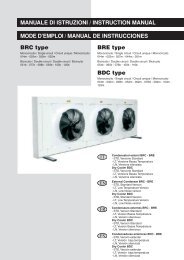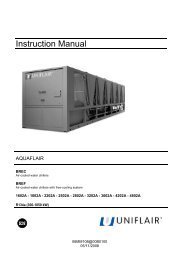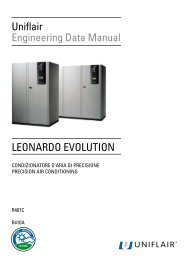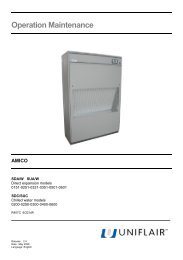TERMINALE EVOLUZIONE GB CLV V3:TERMINALE EVOLUZIONE ...
TERMINALE EVOLUZIONE GB CLV V3:TERMINALE EVOLUZIONE ...
TERMINALE EVOLUZIONE GB CLV V3:TERMINALE EVOLUZIONE ...
You also want an ePaper? Increase the reach of your titles
YUMPU automatically turns print PDFs into web optimized ePapers that Google loves.
2) Installation<br />
These serial interface boards must be fitted onto the pCO1<br />
motherboard, in the special slot shown here.<br />
Mounting<br />
To install the card in the pCO unit respect the following instructions<br />
(Fig.1...4):<br />
1. remove the "serial card" placement cover with a screwdriver<br />
(Fig. 1);<br />
2. removing the pre-punctured plastic you get the hole which corresponds<br />
to the tree-pole terminal out (Fig. 2);<br />
3. insert the optional card into the corresponding connector, taking<br />
care that the card is firmly placed on both plastic supports on<br />
the pCO case (Fig. 3);<br />
4. close the cover using the screwdriver making the outside card<br />
terminal fits with the punched hole made on the cover (Fig. 4).<br />
The connection with the RS485 network is carried out by means<br />
of the plug-in terminal connector on the card. Pin-wiring of the<br />
connector is stamped on the card (see table 1). If the card is<br />
placed in the last position of the supervision serial line, pins 2 and<br />
3, you must connect a 120 -- 1/4 W end line resistor, as shown in<br />
Fig. 6.<br />
Obviusly it cannot be placed more that 1 serial card at same time<br />
inside the PCO1 mother board. Consequently unit can communicate<br />
just whit 1 BMS system at same time<br />
Warning. When handling the card, please follow the<br />
advice below<br />
Electrical damage may occur to the electronic components as a<br />
result of electrostatic discharges from the operator. Suitable precautions<br />
must be therefore be taken when handling these components:<br />
before using any electronic component or card, ground yourself<br />
(not touching the card does not prevent a spike, as static<br />
electricity can produce a 10000V spike discharge which can<br />
form an arc of about 1cm);<br />
all components must be kept inside their original package as<br />
long as possible. If necessary, take the board from its package<br />
and place it into an antistatic package without touching the back<br />
of the board with your hands;<br />
absolutely avoid non-antistatic plastic bags, polystyrene or<br />
spongee;<br />
do not pass the card directly to other operators (to prevent<br />
from electrostatic induction and discharges).<br />
EVOLUTION TERMINAL<br />
fig. 1<br />
fig. 2<br />
fig. 3<br />
fig. 5<br />
1 2 3<br />
fig. 4<br />
pin<br />
1<br />
2<br />
3<br />
significato<br />
GND<br />
RX+<br />
/ TX+<br />
RX-/<br />
TX-<br />
English<br />
27






